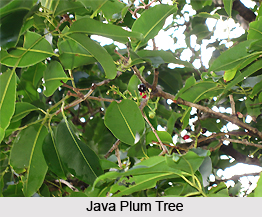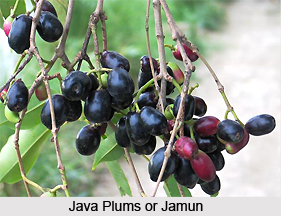 The tree "Java Plum" is amongst the most common evergreen trees of India, Burma, Sri Lanka and Malaysia except the waterless districts. If grown in a suitable place, the tree becomes tall and handsome. It chiefly found along riverbeds and it usually has a twisted trunk and a lot of branches. Though it is common in Mahabaleshwar, there it appears like most other trees as knotted and undersized. In all forest districts of South India, it grows up to.1800 m. The sweeping branches and large, smooth leaves, most of which are pendent, provide the grace of one well-grown "Java Plum" tree. The bark of tree is uneven and light grey. It contains some large patches of darker grey in colour and thin gloominess where the bark has stripped off.
The tree "Java Plum" is amongst the most common evergreen trees of India, Burma, Sri Lanka and Malaysia except the waterless districts. If grown in a suitable place, the tree becomes tall and handsome. It chiefly found along riverbeds and it usually has a twisted trunk and a lot of branches. Though it is common in Mahabaleshwar, there it appears like most other trees as knotted and undersized. In all forest districts of South India, it grows up to.1800 m. The sweeping branches and large, smooth leaves, most of which are pendent, provide the grace of one well-grown "Java Plum" tree. The bark of tree is uneven and light grey. It contains some large patches of darker grey in colour and thin gloominess where the bark has stripped off.
The scientific name of the "Java Plum" read as "Syzygium Cumini". The word "Syzygium" came from the Greek word "suzugos" that means, “pairedâ€. It derived from the family of "Myrtaceae". It"s known as "Jaman", "Jam", "Kala Jam", "Phalinda", "Jamni" or "Phalani" in Hindi. The Bengali people call it as "Kala Jam", "Phaunda", "Paiman" or "Bahojaman". It"s called "Naval" in Tamil and "Neredu" in Telugu. In English, the name of this tree is "Java Palm" or "Indian Allspice".
The unremarkable, whitish flowers of the tree are seen from the month of March to May. They usually grow in open, stalked bunches from small side stems below the leaves. As a result, a casual observer cannot see it. Each of the little sweet-smelling flowers is like two little caps closed against each other. One flower is the calyx that remains, and the other is the petal, that is in one piece instead of being divided. The upper “cap†falls down and releases a group of stamens. These stamens spread out over the edge of the calyx “capâ€. At First the little plums are pink and green in colour but being ripen, they become purple-black. Varying in size up to 3.8 cm, there are a lot of varieties. Some of the flowers are very sweet and pleasant in flavour, and others are small and sharp.

The leaves grow just in the opposite way of the flowers. They are oval shaped and terminate in a minor point and also very smooth and closely lined. These lines have a characteristic pattern. They run diagonally from the center rib, and most of them join up with a curvy, insignificant rib. Along with the leaves, the fruits also vary with different trees. Normally, a leaf is long up to 7.5 cm. At the beginning, the leaves are fresh and clear green. But after some weeks, they take a deep green colour. They have the specific smell of turpentine. As the "Java Plum" is blessed to Krishna and to Ganesh, the Elephant God, it is planted very often near the Hindu Temples. Not only the Hindus, Buddhists also adore this tree.
Apart from the religious values, the tree has some useful qualities as well. The wood from the "Java Plum" tree is adequately hard and durable so that it can be used to make carts and people also implement this for buildings. It makes some good fuel as well. Spirituous liquors can be distilled from the juice of ripe fruit and vinegar is made with this liquor. One of the "Java Plum" trees can also produce the silkworm called “Tasarâ€. The bark of the tree is used for dying and tanning. This is used to make medicine for a specific kind of Dysentery as well. A remedy for this complaint is also decocted from the unripe fruit.



















